France has a large pool of talent in pretty much any department.
In defence, especially, they have so many talents with wide range of abilities and unique skillsets.
From ball-playing defenders who can play in the midfield, defensive full-backs who can play as a ball-playing centre-back, attacking full-backs, limited centre-backs, or any other types of players – France has it all.
One talent that has been particularly impressive this season is RC Strasbourg Alsace’s Mohamed Simakan.
The Marseille-born defender only made his debut this season but has immediately earned the trust of manager Thierry Laurey and has been consistently producing magnificent displays throughout the season.
Though naturally a centre-back, Simakan has been deployed mostly as a right-back throughout the season, playing the role of defensive full-back.
In this tactical analysis and Mohamed Simakan scout report, we’ll be taking a detailed look at the Simakan’s abilities, tactical tendencies, as well as role in Strasbourg’s tactics.
Mohamed Simakan Style Of Play & Player Profile
Simakan is 1.87 m and weighs around 82 kg.
He seems to have medium build, with a decently developed upper and lower muscles.
Certainly not a bulky player but not skinny as well.
He seems to be naturally fit and athletic.
Talking about strength, Simakan possesses good upper and lower strength and this helps him a lot in both ground and aerial duels.
The 2000-born defensive full-back is strong and difficult to shrug off the ball.
Even when going against an opponent with larger frame, Simakan is usually still able to fare well in physical duels.
Meanwhile, smaller opponents tend to be easily dominated physically by him.
Not only good at jostling for the ball, Simakan is able to use his body well to protect the ball when he’s in possession.
He’s certainly quite hard to push off the ball although his technical ability on the ball is rather limited.
Of course, aside from his impressive strength, his aggression, as well as determination, plays a big part in winning duels.
He’s not the type of player that goes down and gives up easily and will look to do everything he can in order to win the duel.
Though at times he may be beaten in an offensive/defensive duel, he’ll try to take responsibility for it and chase down the ball carrier or quickly recover and get back into position to defend.
Simakan is quite strong in aerial duels.
Having a good height combined with excellent athleticism and coordination, Simakan is able to reach good vertical height when leaping.
Aside from his physicality and athleticism, Simakan also reads the flight of the ball very well, thus allowing him to get into good positions and then time his jump perfectly.
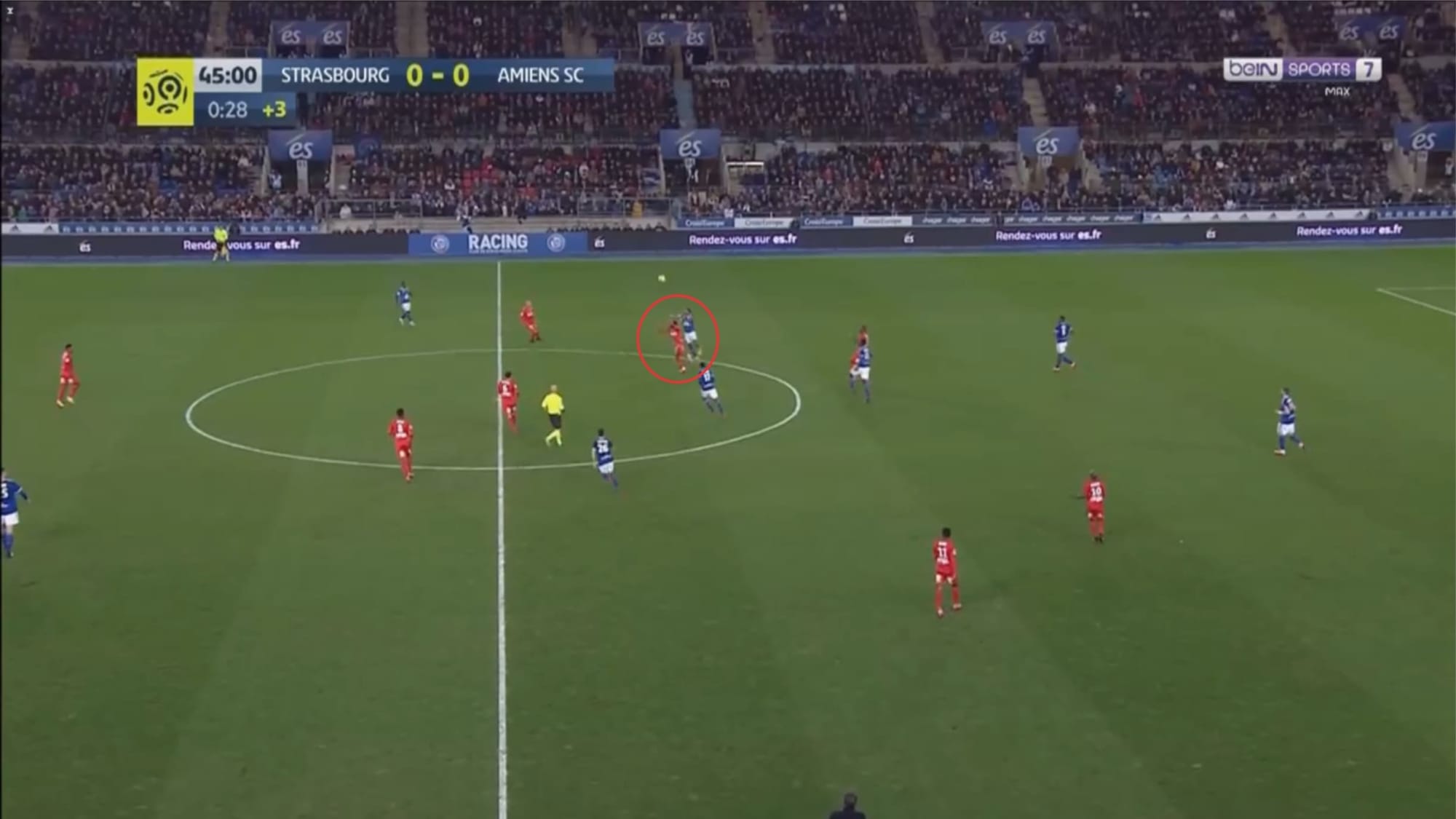
Statistically, Simakan records an average of 4.77 aerial duels per game with a success rate of 51.8% which is pretty decent but certainly can be improved in the future.
He’s quite active in engaging in aerial duels and he’s certainly quite useful in offensive and defensive set-piece situations.
One particular thing that stands out in his aerial duels is his ability to direct the ball well with his head.
This is mainly due to his body coordination and neck power.
In the air he’s able to generate a powerful header with good accuracy, thus helping his team win second balls and making him effective in aerial duels despite not really having a very high winning rate in this particular area.
Simakan can be quite aggressive when duelling both in the air and on the ground, both in open play and in set-piece situations.
He likes to use his limbs and will try to push or pull his opponent, making sure that he has the upper hand in the situation and try to make it very difficult and very uncomfortable for his opponent to properly leap and make perfect contact with the ball.
Mainly being played as a right-back, however, Simakan finds himself going face to face against smaller but very quick, explosive attackers more often compared to big, strong opponents.
However, he’s certainly not sluggish either.
Simakan has a pretty decent burst of acceleration.
He’s not a particularly explosive player which is why it would take a few strides before he reaches his top speed.
But he’s certainly sharp and agile enough which can help him a lot when having to deal with pacey and explosive wingers over short-range.
And aside from his physicality, his intelligence in terms of positioning his body and keeping distance with his opponent in defence is certainly crucial, but this will be explained later in this tactical analysis/scout report.
Though he can’t be described as an explosive player, he certainly possesses very good pace and athleticism which can be seen when he reaches maximum speed.
Despite usually starting (his run) rather slow, he can reach great speed and this allows him to cover medium-long distances very quickly which can be useful especially in offensive and defensive transitions.
And aside from his speed over short, medium, and long-range; Simakan is also quite agile and well-coordinated despite having a rather tall frame.
Simakan seems to be able to change directions quickly, particularly off the ball.
He shows no signs of struggling to rotate his hips and turn over his shoulder at all though he does seem to take small intermediate steps when changing directions in high speed.
His agility coupled with decent acceleration allows him to keep up with quick, agile attackers which again, makes him quite difficult to beat in 1v1 duels.
Meanwhile, on the ball, his posture seems rather stiff.
He doesn’t use feints to beat his man and changing directions with the ball in high speed may cause him to lose control of the ball which is not ideal.
This, however, should be attributed to his limited on-the-ball ability rather than his agility.
Lastly, Simakan seems to have a pretty good endurance level.
His performance throughout the full 90 minutes are usually stable and he doesn’t show signs of significantly slowing down.
However, still signs of fatigue can be seen as he occasionally doesn’t react quick enough to certain situations and a bit more reluctant to chase down ball carriers in the latter stages of the game.
He’s a pretty energetic player and it’s impressive to see him being able to cover a good amount of distance on the flank and sprint up and down the pitch as well as engaging in physical duels both in the air and on the ground numerous times in the game.
Mohamed Simakan Ball handling
Aside from having good physical prowess, Simakan also has a pretty decent overall technical ability on the ball.
In this section, we’ll take a closer look at his ball control and dribbling.
Simakan has a pretty decent ball-handling ability and is quite strong with both feet.
He’s able to receive a pass with a good touch and control it well with either foot or even his chest before executing his next action though at times, he does seem to struggle if the pass is a bit too sharp.
And though it’s a bit rare to see him knocking the ball too far or accidentally lifting it off the ground when receiving an accurate and well-weighted pass, sometimes those things can still happen in a game; especially if he’s receiving under pressure.
Simakan likes to receive with an open shape, usually preferring to receive with the inside of his back foot.
This allows him to have a good vision of the pitch and this seems to result in quicker decision making and reaction.
At times he can also be seen receiving the ball with his sole before quickly rolling the ball towards the direction he wants to play to; or at times, with the outside of his front foot.
He’s comfortable in receiving with either foot and there doesn’t seem to be any significant difference in terms of quality when he receives with his right of left foot.
The main problem for Simakan when on the ball is certainly not because of his physicality but mostly due to the lack of natural flair as well as a limited variety of technique on the ball.
This is why he tends to avoid static 1v1 offensive situations and prefer to keep the ball moving, knowing that he’s difficult to push off the ball when on his stride.
Aside from that, it does seem like Simakan tends to rush his decisions and unable to keep his composure when under pressure, resulting in poor, questionable actions or imperfect executions.
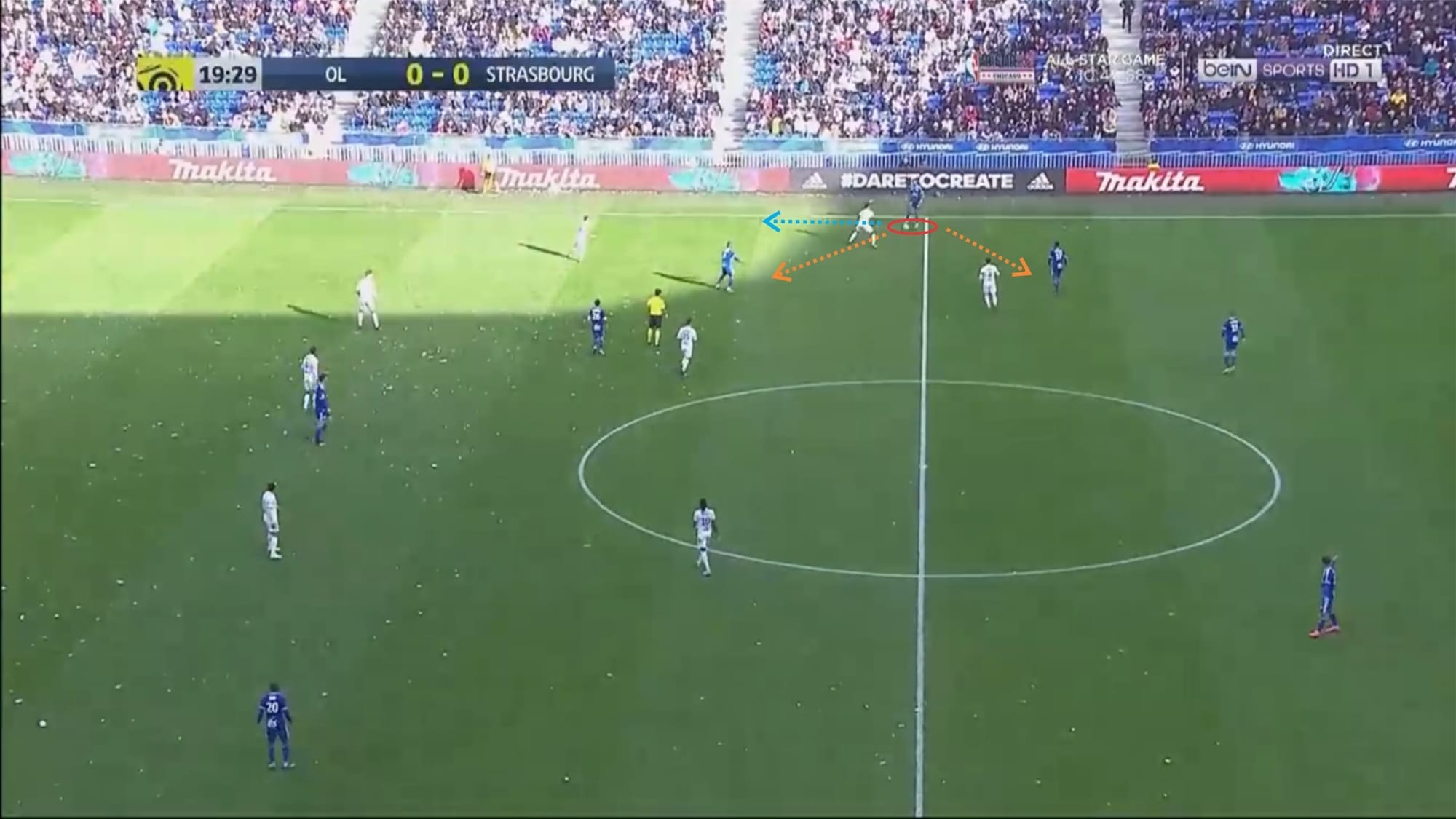
In the situation above, for example, Simakan found himself in a 1v1 situation with an opposing winger.
He does have several options in this case but he ultimately chose the one difficult option, which is to pass the ball towards a teammate behind his direct opponent’s shadow cover.
Fortunately, his opponent didn’t manage to block the pass and it eventually found its way towards the foot of the intended target.
He could have passed the ball back or try to beat his man with a direct dribbler but chose the hardest option instead.
When dribbling, Simakan seems to be able to switch his lead foot which makes him quite flexible on the ball and his opponent may not be able to figure out with which foot he is going to deliver a pass/cross or hit a shot.
Mainly, however, Simakan prefers not to dwell on the ball and doesn’t dribble very often, preferring to quickly play a pass/exchange passes with his teammate(s) in order to avoid pressure.
As mentioned before, though he’s quite an agile and well-coordinated player; his body seems quite stiff when on the ball and he rarely uses feints to beat his man.
Mainly to beat his man, Simakan will try to knock the ball past his man and try to outpace and outmuscle his opponent to the ball, preferring to be very direct rather than technical.
At times, of course, this move may be quite effective, especially if he’s going against an opposing defender that he can physically dominate.
It’s rare to see him try tricks although he can be seen improvising when in a difficult situation.
Against Lyon (16 February 2020), for example, Simakan can be seen attempting a Marseille turn to get past multiple players though ultimately he failed to gain control of the ball and lost possession.
This does show a bit of confidence and creativity but the execution certainly needs to be improved.
Statistically, Simakan registers an average of two dribbles per game with a success rate of 61.7%.
He also records an average of 4.73 offensive duels per game with a winning rate of 56.8%.
Those numbers aren’t really bad actually and they do show that he is pretty effective and efficient on the ball despite his limited ability in this particular area.
For comparison, defensive full-back Josha Vagnoman of Hamburg records a higher average of 3.74 dribbles per game but has a lower success rate of 53.7%.
The latter also has a much higher average of 10.16 offensive duels per game but has a significantly lower winning rate of 36.8% showing that the latter indeed likes to take on his opponent(s) more often compared to Simakan.
The lower success rate of the latter may also be because of his tendency to advance forward and take risks more often than Simakan despite still playing in a similar role.
Mohamed Simakan Distribution and delivery
Mainly Simakan prefers to play short-medium passes in a game.
His target may vary, at times he may look to pass straight towards his teammate but some other times, he tries to pass into space.
This certainly depends on the situation around him and how he reads the game.
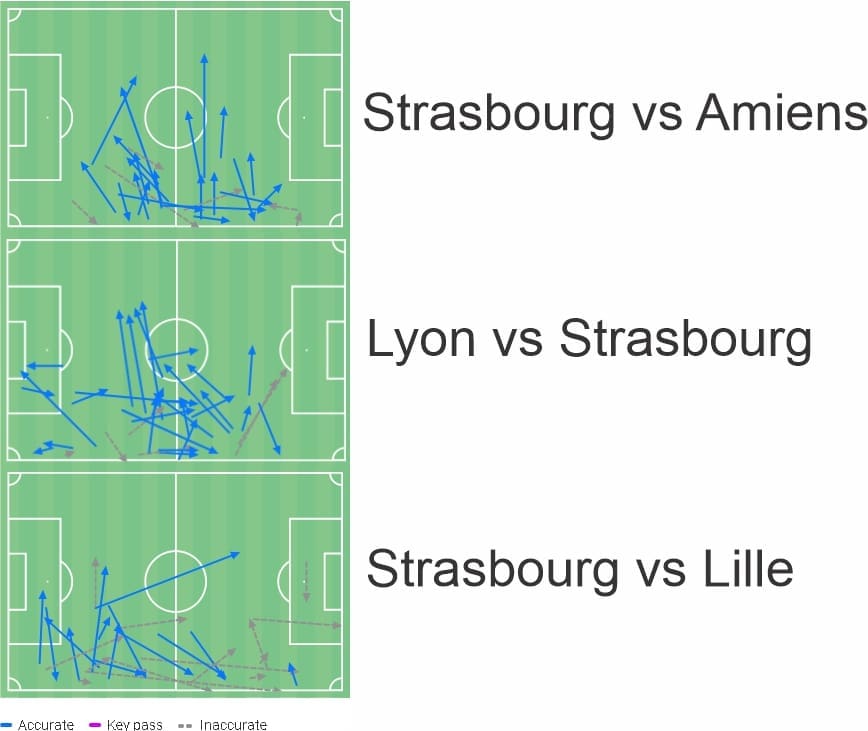
Above you can see his pass maps in the last three matches where he plays the full 90.
You can see his tendency in the pass maps above.
Simakan likes to play lateral passes towards the nearest centre-back or towards one of the central midfielders.
He also can be seen playing a lot of short vertical progressive passes towards winger on the same flank but rarely plays diagonal passes towards winger on the opposite side.
He does occasionally try to switch play by playing a lofted pass towards the opposite full-back.
Some other times, Simakan can also be seen trying to play through passes into space behind the opposing full-back (same flank).
It’s quite rare to see him play a long pass from the back towards the striker though and he seems to prefer to play the ball towards the near winger, centre-mid, or centre-back instead.
He does like to try risky, difficult passes at times when he sees an opportunity to do so, but he mainly likes to play safe passes in a game.
Statistically, Simakan attempts an average of 43.53 passes per game with a decent success rate of 82.7%.
Out of those total passes per game, Simakan averages 15.22 progressive passes (71.7%) as well as 5.29 long passes (52.4%) per game.
Those are pretty decent numbers though there are certainly lots of room for improvements.
The main problem for Simakan when it comes to passing seems to be his tendency to direct the ball towards the “wrong” side of the receiver.
An example of this can be seen below.
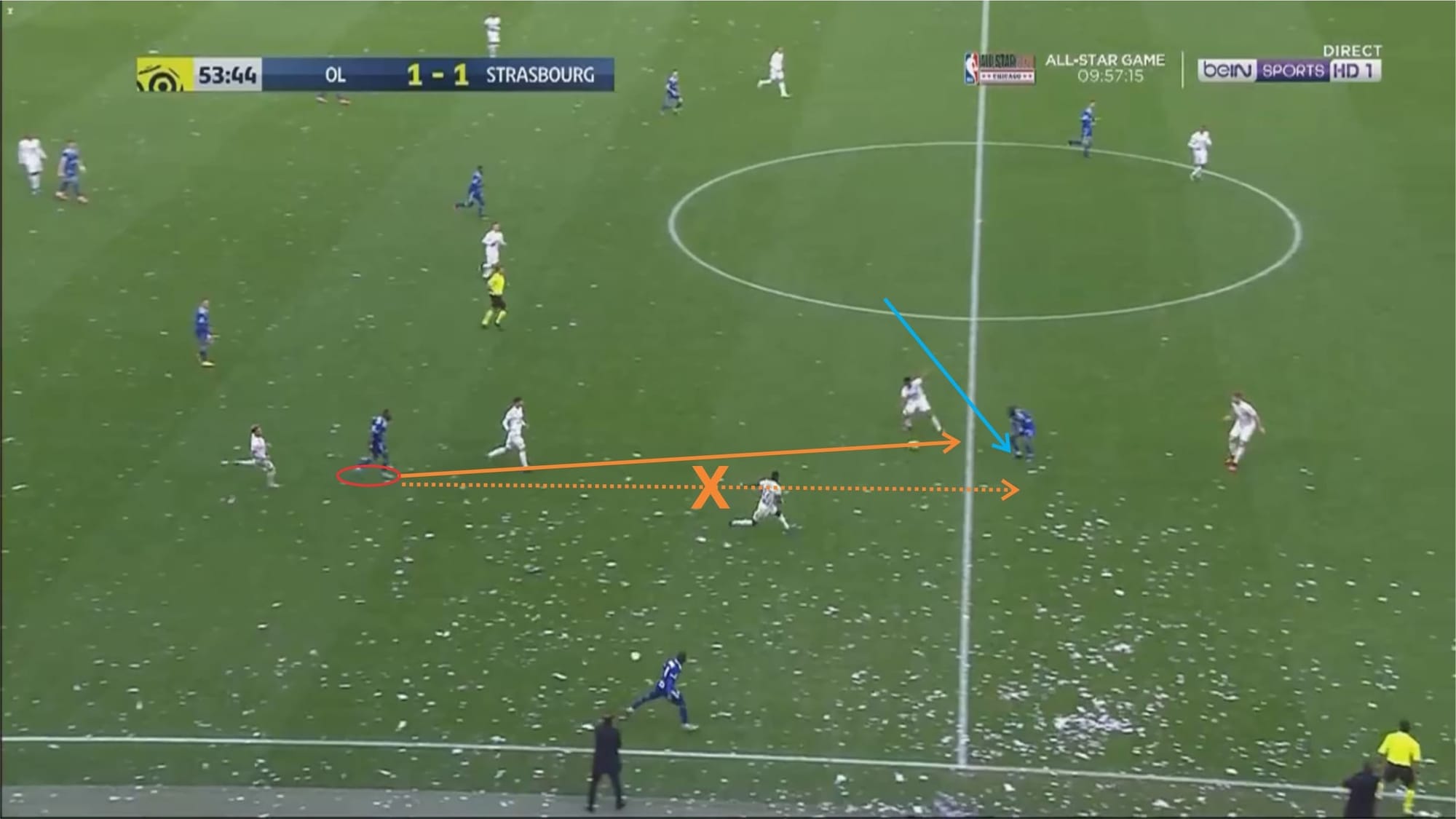
In the picture above, Simakan tried to play a pass towards a teammate who made a diagonal outward run from a central position towards the half-space.
He saw the run and played the pass.
In this particular situation, as his teammate was being followed by an opponent and as his teammate was making an outward run in moderate speed; directing the ball in front of the receiver so he can receive it comfortably and potentially combine with the winger who’s free on the flank would be the best choice.
However, Simakan played the pass towards behind the receiver and the opposing player managed to intercept it.
He did show good ability to spot the run and bravery to make a difficult pass though, so that should also be taken into account although once again, the execution was improvable.
Situations like in the image above happen rather often and though they don’t always lead to loss of possession, they sure may lead to loss of momentum.
This problem doesn’t seem to be due to poor decision making and awareness but seems to be mainly because of poor execution.
Simakan tends to play his passes with good pace.
He usually hits his passes with the perfect power, not too sharp but also not to slow.
He also seems comfortable using either foot to pass the ball although there seems to be a slight difference in terms of quality when he plays passes with his right or left foot.
With his left, he is more prone to mishitting his pass, resulting in a pass that’s either too weak or too sharp or just simply inaccurate.
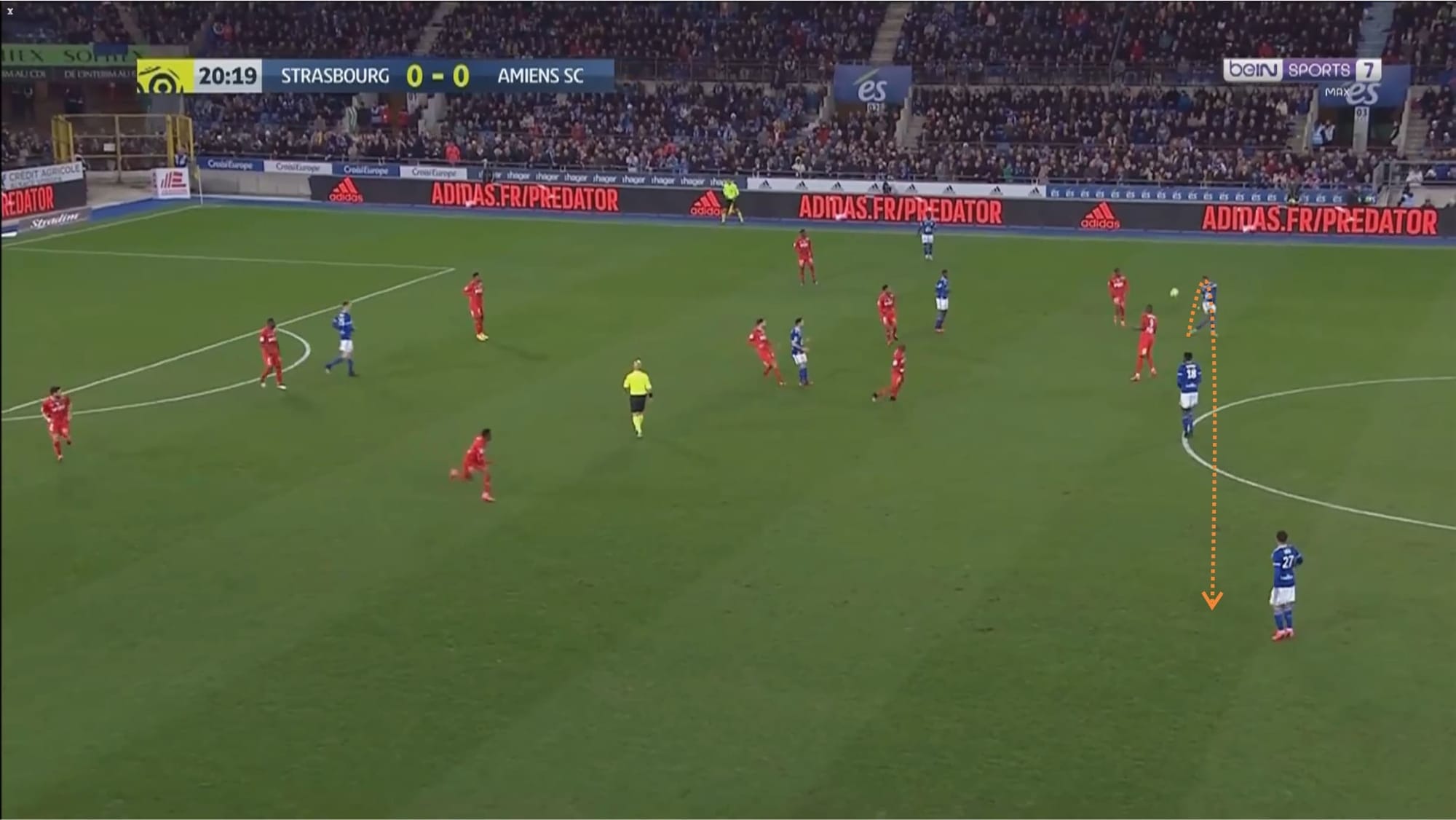
When it comes long passes, Simakan seems to have a rather limited variety of technique that he usually uses.
Mainly he’d just try to loft the ball straight towards his teammate rather than into space.
He likes to hit the underside of the ball, producing a lofted pass with more backspin rather than trying a low driven long pass.
Being a defensive full-back, Simakan doesn’t solely focus on defence but he does also play a minor part in attack.
At times, he can be seen going forward and trying to deliver a cross.
Mainly, Simakan will choose to deliver crosses from deep rather than from the byline.
It’s quite clear, however, that he’s still weak in this particular area as he’s often still unable to control the power and direction of the delivery.
His movements and preparation before hitting the cross also can often be read and thus the cross can usually be blocked by his direct opponent.
Statistically, Simakan averages 1.62 crosses per game with a success rate of 36.8%.
The low number of crosses does indicate that he doesn’t really fancy delivering crosses, mainly preferring combinations on the flank and often looking to give the ball towards more creative teammates instead.
As can be seen, his success rate is also disappointingly low which indicates his inability to find a teammate with his cross.
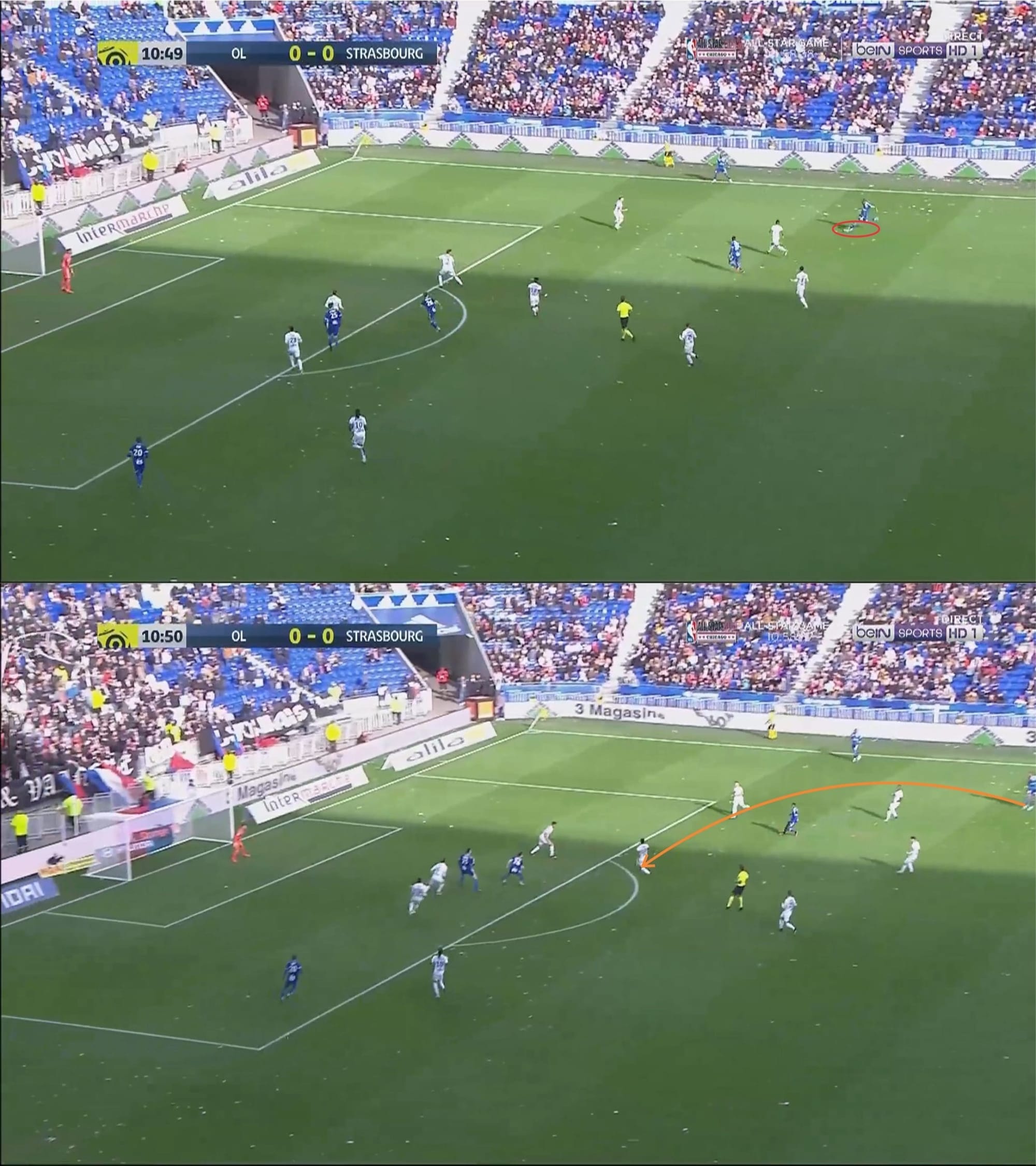
In the image above, for example, Simakan had the ball on the right-wing.
Though he had an option to play a pass towards his teammate in front of him, he decided to cross early instead.
However, his cross was successfully intercepted by an opponent.
It didn’t find the intended target as it didn’t travel far in the air and had too much curve to it.
It was simply too weak and inaccurate.
Mohamed Simakan Position at Strasbourg and tactical tendencies
As mentioned here several times, Simakan is most often deployed as a right-back; playing in the role of a defensive full-back.
His positional tendencies can be seen in Mohamed Simakan heatmap below.
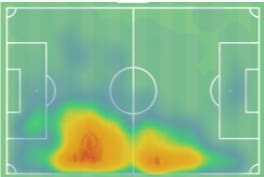
As you can see in the heatmap above, Simakan cover quite a large area on the right flank and the half-space inside his own half and he’s most active below the halfway line.
He also generates a decent amount of activity and it’s not rare to see him covering the space above the halfway line although he tends to stay only around the middle third and doesn’t get to the byline very often.
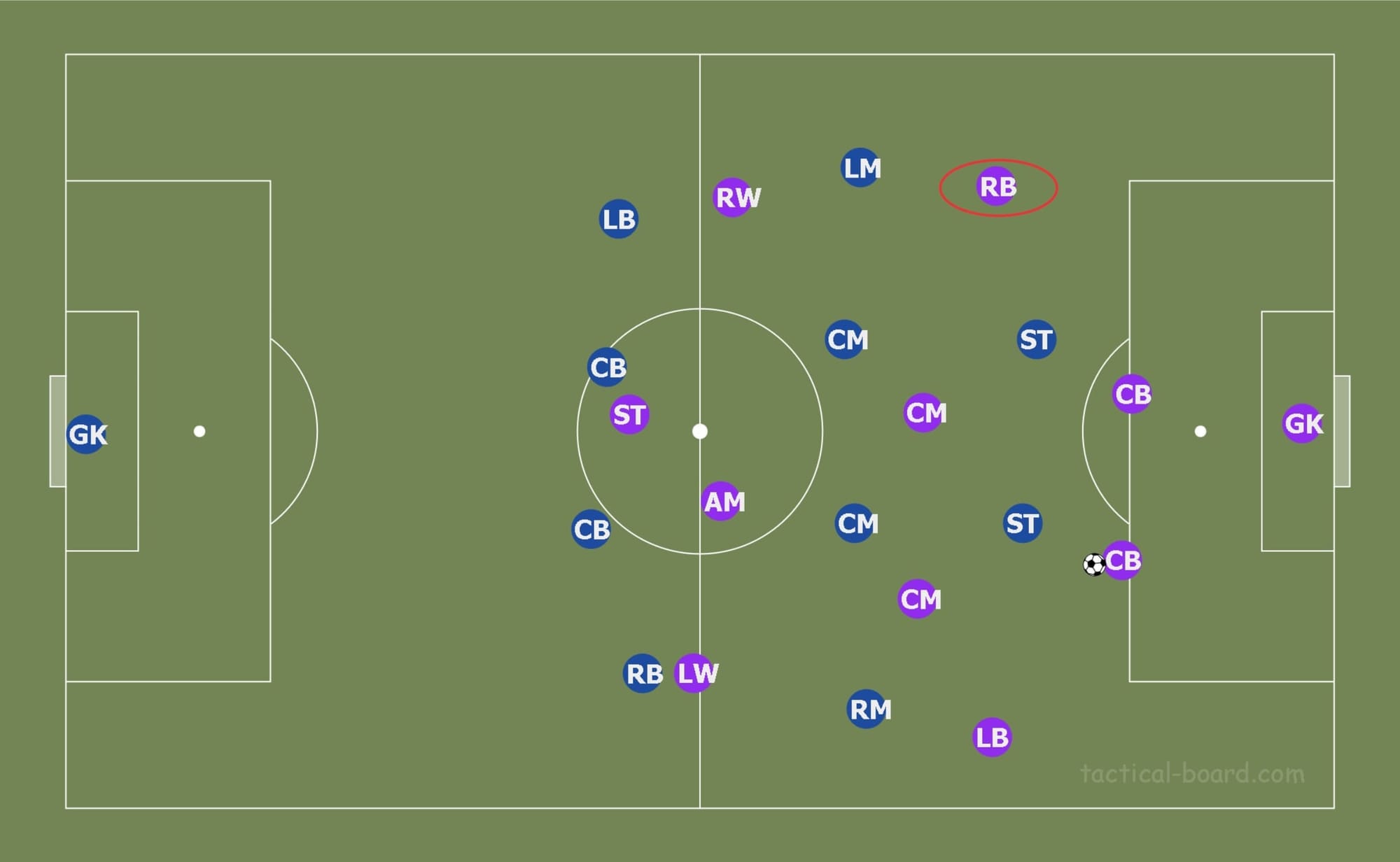
In the build-up, both full-backs (including Simakan) tend to stay a bit higher rather than staying flat with the two centre-backs.
Strasbourg are very flexible when it comes to starting formation.
They are also quite flexible in the build-up as at times they’ll choose to play out from the back but some other times they’ll try a long distribution right from the goal kick.
It’s also not rare to see the goalkeeper distribute the ball short and then seeing the centre-backs playing a long ball towards the target man upfront (usually Ludovic Ajorque).
In the example above, Strasbourg are using a 4-2-3-1 formation with a double pivot at the back and try to play out from the back.
As you can see in the build-up, they’re creating a 2-4-4 shape.
Both full-backs will usually stay a bit higher than the backline but will drop to receive to support the backline if there’s not available passing option nearby.
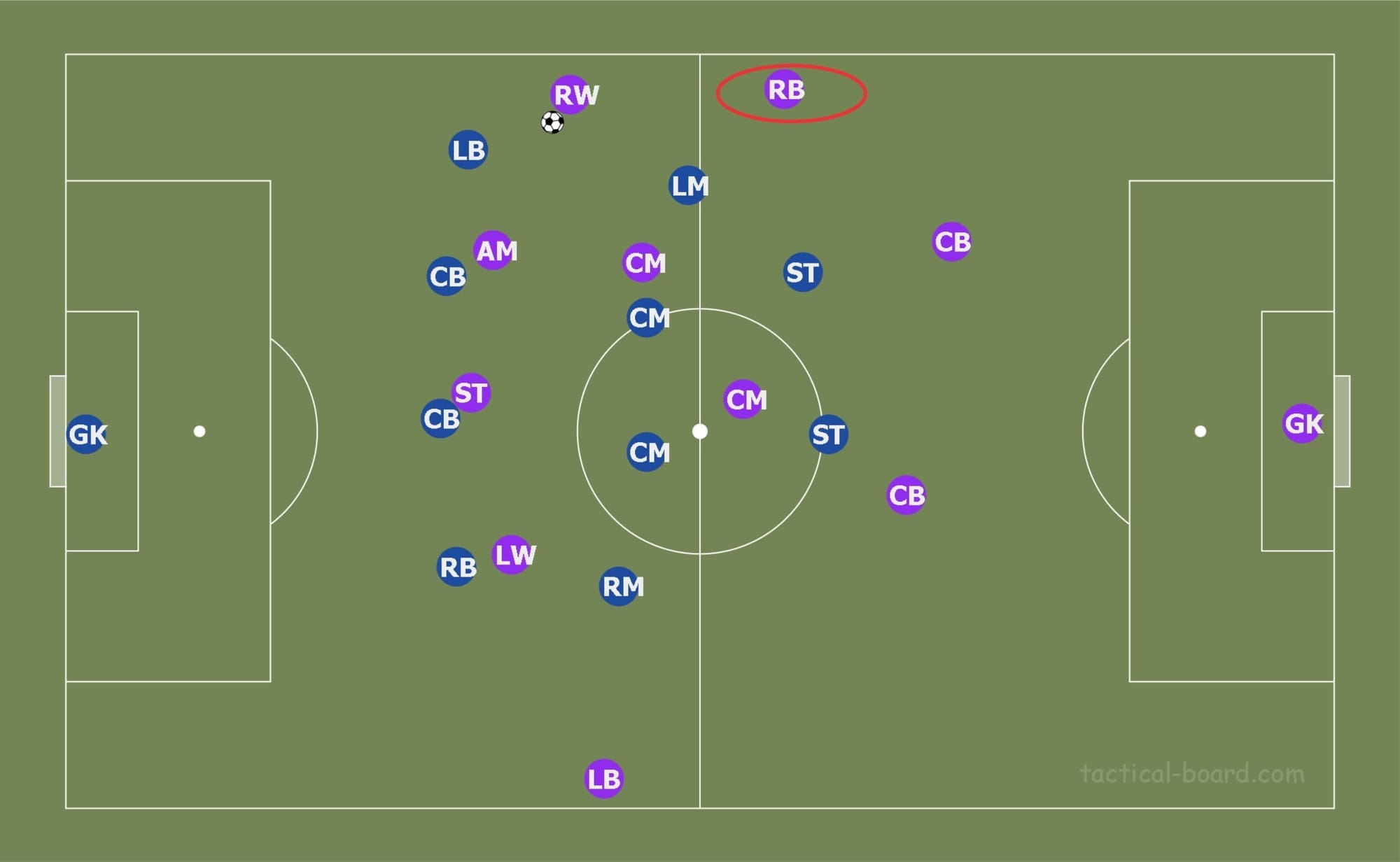
When the ball’s in his flank, Simakan doesn’t always try to overlap but will often stay nearby and provide a passing outlet in case progressive options are blocked.
Notice in the picture also that the full-back in the opposite side is high and stretches the opposing defence wide which is quite different than Simakan’s tendency which you’ll see in the image below.
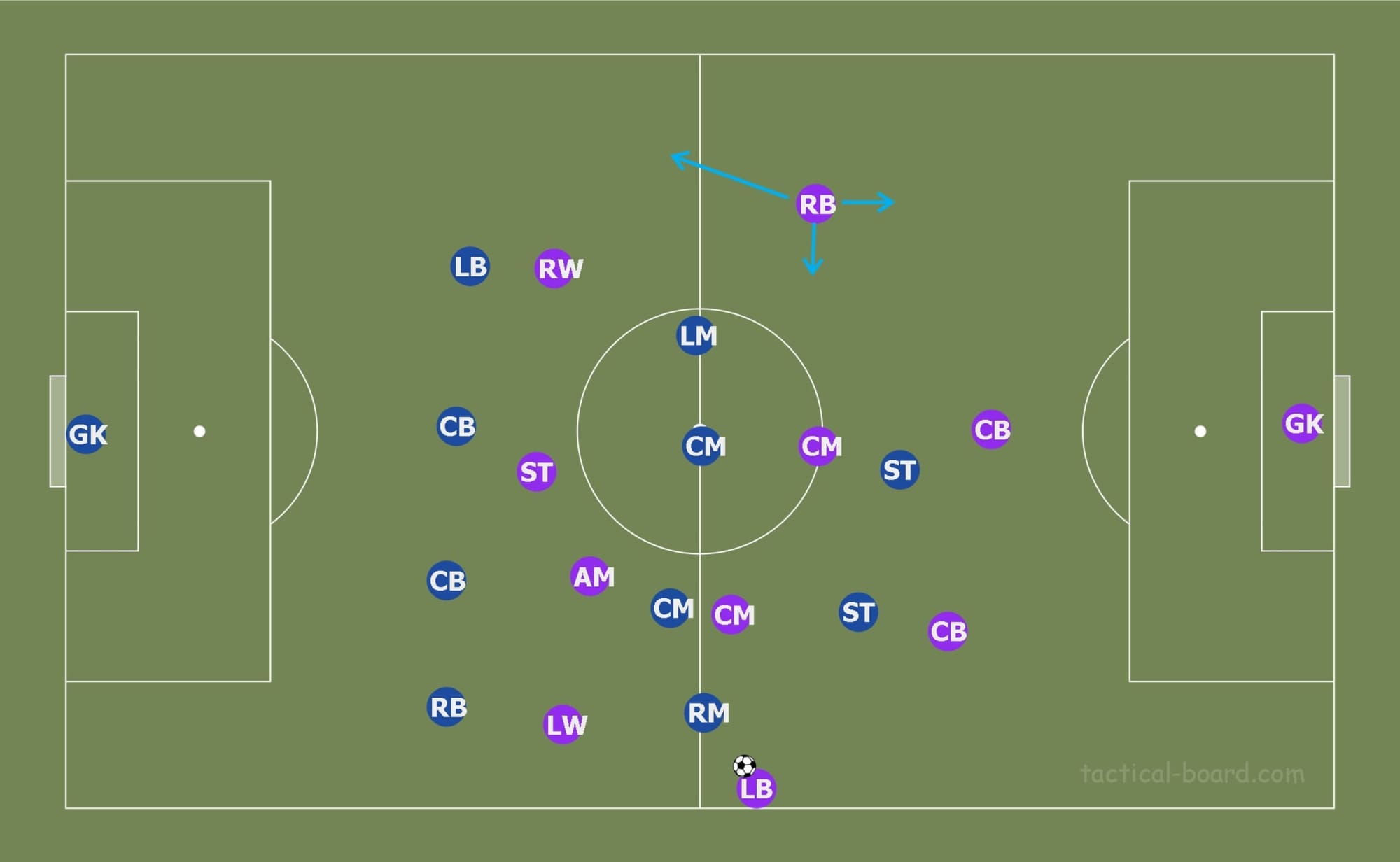
As you can see, if the ball is on the opposite side, Simakan usually doesn’t sit high and wide to stretch the defence, but rather maintain a rather deep position and sit in the half-space or in a central position instead.
This is mainly due to Strasbourg’s tactics.
Simakan is tasked mainly to anticipate counter-attacks instead of supporting the attack.
As you can see, if Strasbourg lose possession, they usually have at least one central midfielder in front of the backline as well as three defenders at the back.
On some occasions, however, Simakan will look to sit high and wide, making himself available as a switch play option if his team are trapped on the opposite side.
So, he can be quite creative and flexible in his role rather than strictly focusing on defence.
However, with Simakan tending to position himself rather deep and inside central area/half-space rather than high and wide, he’s essentially becoming the third centre-back who occasionally overlaps when in the attack.
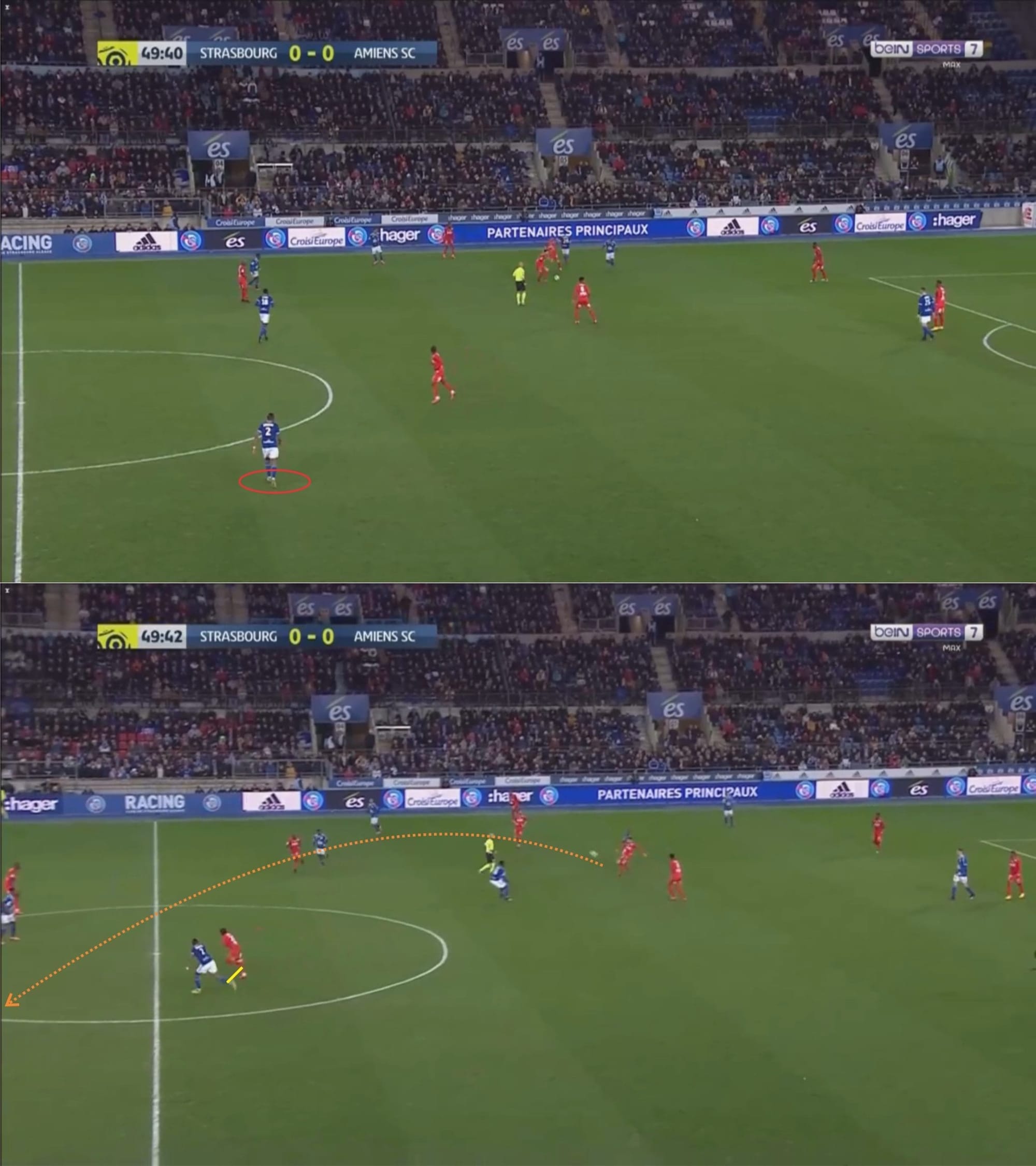
In the image above, for example, you can see his positioning when the ball’s on the opposite side.
His team eventually lost the ball and suddenly found themselves under attack.
Fortunately, Simakan was there to anticipate the counter-attack and intercept the pass although he ultimately miscontrolled the ball and it went out for a throw-in.
Moving on to defensive prowess and tendencies in defence.
Mainly what really impresses me when watching him defend is his excellent awareness and smart decision making which often result in intelligent and calculated play.
Though it has been mentioned in the previous section that Simakan may be rather indecisive when on the ball, especially in 1v1 offensive situations; this doesn’t seem to apply to him when in defence.
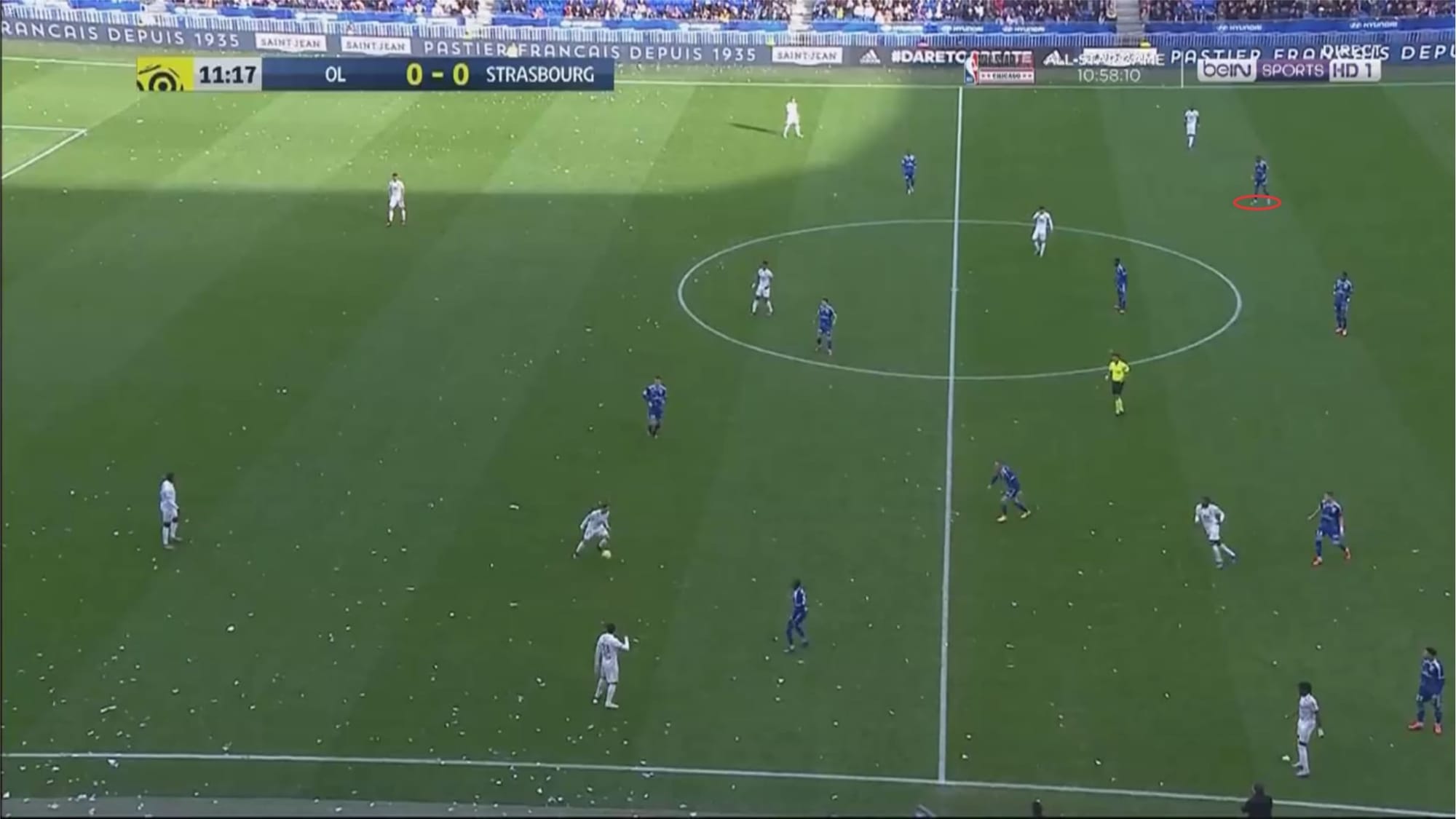
As can be seen in the image above, his shape is open rather than closed; allowing him to have a good vision of the pitch and, of course, a good awareness of his surroundings.
This is mainly why he is able to read the game very well most of the time and reacts very quickly to situations around him.
He also tends not to fixate his eyes on the ball but will scan/check over his shoulder multiple times in every situation, making sure he doesn’t lose sight of his man and his movements.
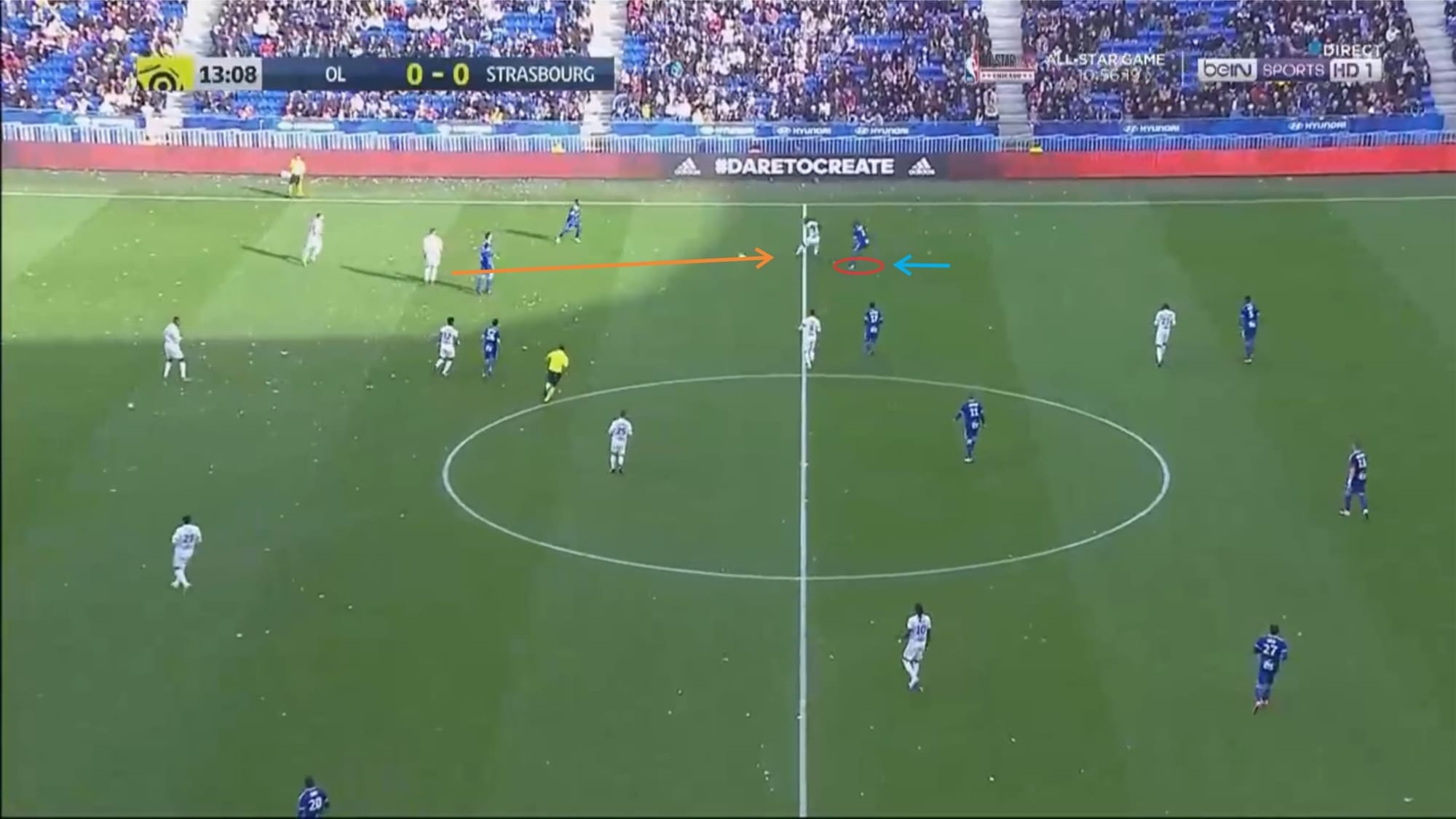
Simakan is quite active in pressing but he usually will try not to venture too far away from his designated position.
Most of the time, if an opponent drops and tries to drag him out of position, Simakan will instead try to communicate with his teammate, either verbally or using gestures, or both.
But if there’s no teammate around, he may improvise and get out of position to press like in the image above.
Usually, Simakan will try to keep a moderate distance with his opponent and presses only when the ball is being played towards the player rather than when the player already has the ball.
That way Simakan can aggressively engage his opponent in a duel, not allowing him to turn and receive comfortably whilst also forcing him into making a mistake.
Having an impressive reading of the game and good tactical understanding combined with great physicality and athleticism as well as high aggression and determination, Simakan can be a very difficult opponent to beat when in a 1v1 situation.
He’s very strong in 1v1 defensive duels.
He’s very patient, positions his body very well, also he’s well-coordinated and is decently sharp over short-range so he’s always able to keep up with his opponent’s movements.
He’s also good at keeping distance and able to adapt to his opponents very quickly.
Against quick and agile opponents, for example, he’ll try to not stay very close to his man.
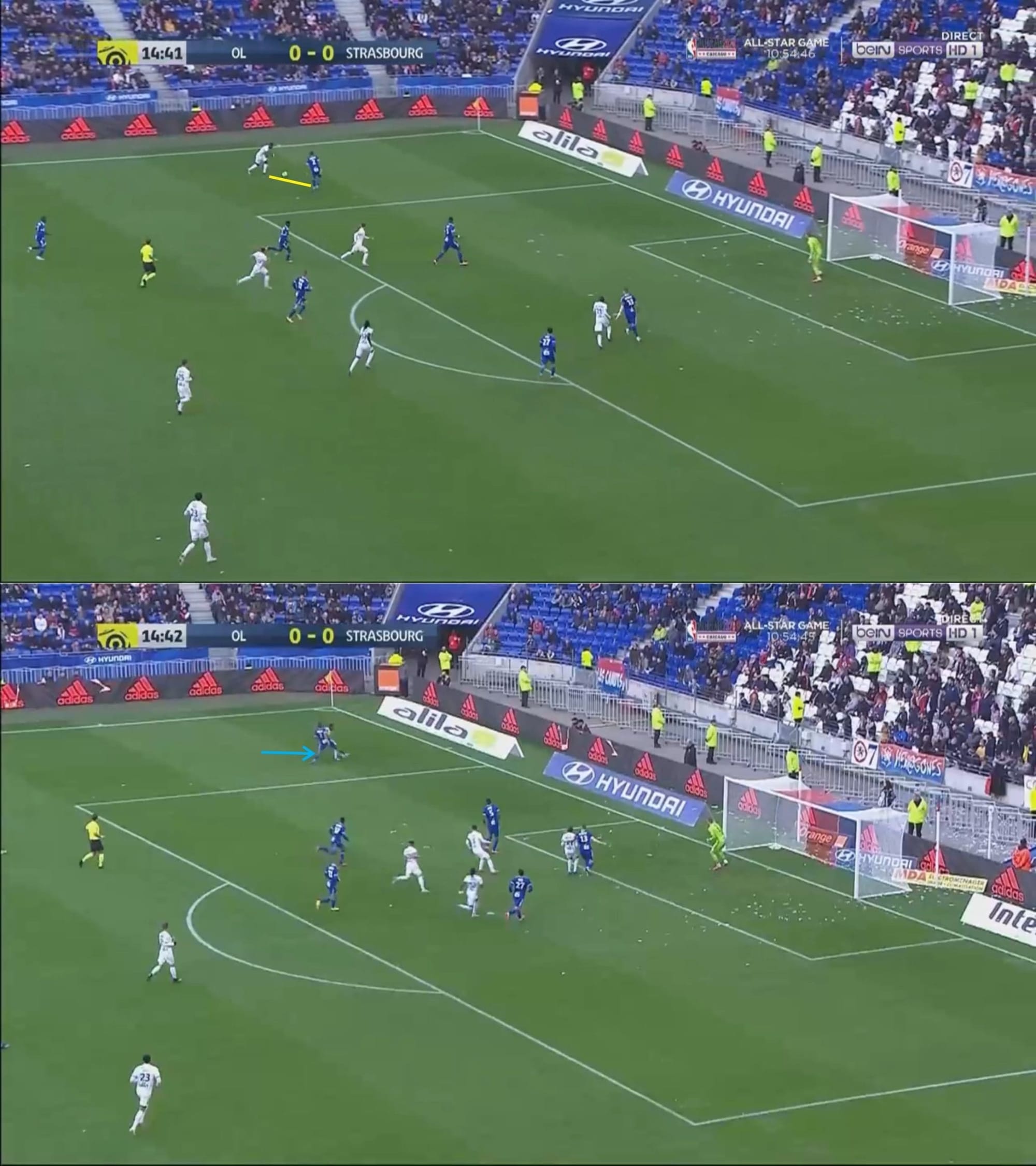
In the image above, for example, Simakan is aware of Maxwel Cornet’s agility and pace and decided not to stay too close to him but still close enough to manipulate his opponent into thinking that he doesn’t have many options in that situation.
He positions his body well and he’s waiting for his opponent to make a decision.
Cornet then decided to try to beat Simakan and knocked the ball forward and accelerated.
The action was well-read by the defender and he stuck out a leg to win the ball.
He timed his challenge perfectly and committed to it and won the duel.
Statistically, Simakan averages 8.02 defensive duels per game with a rather impressive winning rate of 65.4% proving his strength in this area and tendency to be actively involved in defence.
Hamburg’s Vagnoman, for comparison, has an average of 7.79 defensive duels per game with a lower success rate of 59.8%.
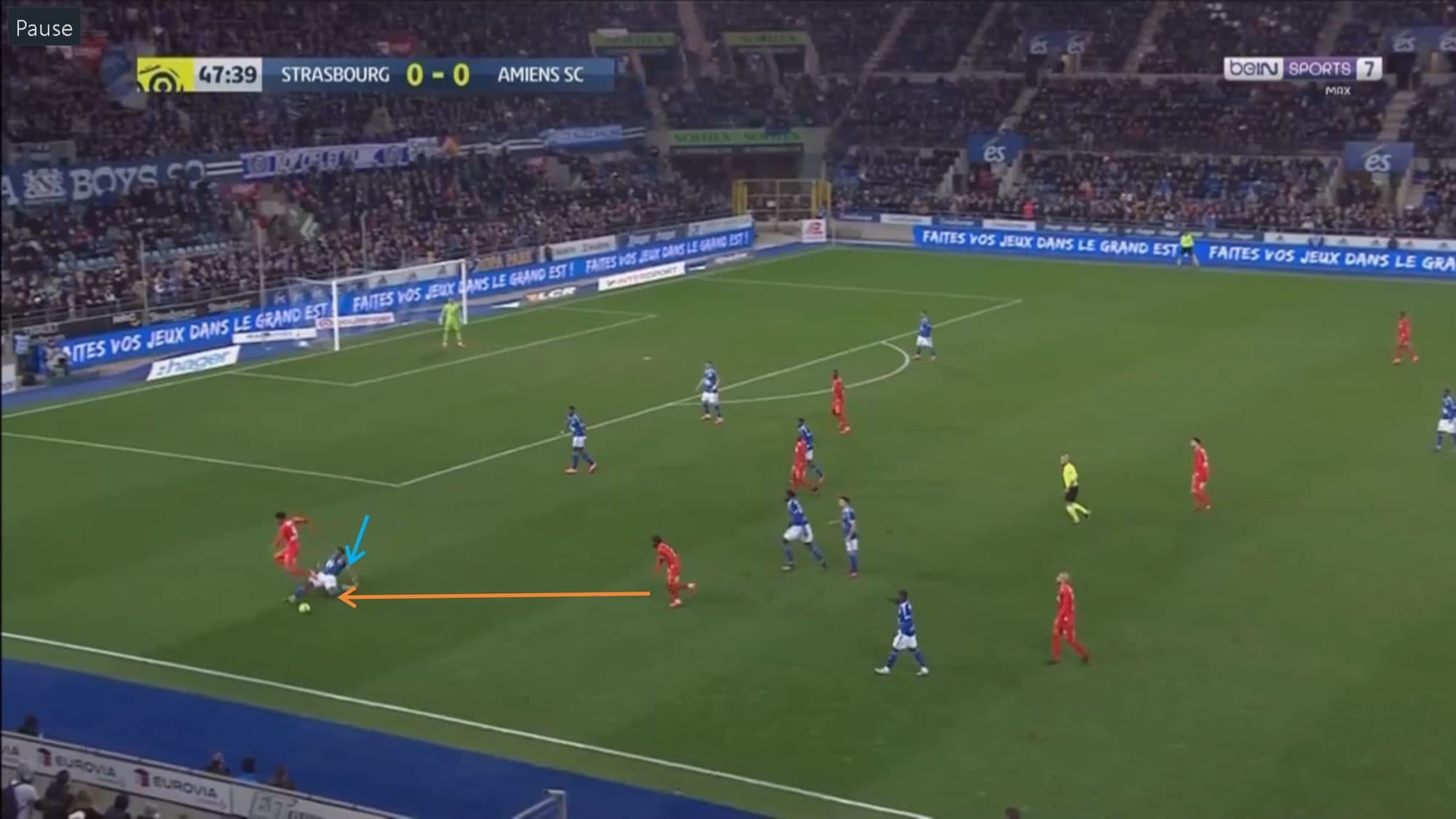
It has been mentioned several times in this tactical analysis/scout report, both explicitly and implicitly, that Simakan is a very aggressive player.
In defence, he’s very brave and never afraid to engage in duels.
He will also get stuck into his challenge and really commit though he is still careful and will always pay attention to the surrounding area before sliding in to intercept/tackle the ball.
Conclusion
There’s little doubt that Simakan is an extremely talented youngster with the potential to be a world-beater in the future.
A highly athletic and naturally fit defender with a good understanding of the game and impressive intelligence.
He’s certainly not quite a polished player yet and his overall technical ability certainly needs to be sharpened if he wants to make it at the highest level but he does show outstanding ability as well as potential.
Surely if nurtured properly, he’ll turn into a magnificent player in the future.
At the moment, Simakan has already drawn interest from a lot of top clubs from top leagues in Europe including Tottenham Hotspur, Everton, Borussia Dortmund, RB Leipzig, AC Milan, Eintracht Frankfurt, and Southampton all reportedly keeping tabs on the 19-year-old Marseille-born defensive full-back who can also play as a ball-playing centre-back.
With so many clubs reportedly linked with their player, Strasbourg are certainly expected to make a big sale this summer but they certainly want to receive a good bid for the exciting prospect who still has a contract until 30 June 2023.





Comments